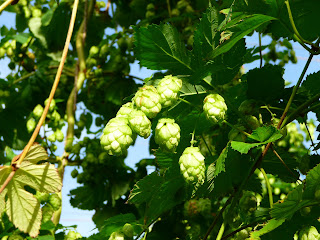But easy though it may be to grow a new hop variety growing a worthwhile new variety is a little trickier. Though some still try Mr Fuggle's method, Peter Darby takes a more scientific approach.
Here's my notes on how it's done at Wye Hops Ltd. :
- Decide which plants you want as parents.
- Put a parchment bag over the mother before the flowers open. The parchment bags allow the hops to breath. Timing is crucial as too early with the bag and the flowers could be aborted, too late and the flowers could be pollinated randomly.
- Add pollen from the father to the bag. It's diluted with powder to prevent clumping.
- Have a bag of unpollinated flowers to use as a control. If these grow seeds then you were too late putting the bag on, random pollination has occurred and your crosses might not be what you think they are.
- Gather the seeds from your hop crosses.
- Sow 20,000 seeds each year.
- Expose the plants to downy mildew. This will kill 5 out of 6 of the plants.
- Expose the plants to powdery mildew. This will kill more.
- Select 1400 to 1500 hops to plant in a field.
- Let them grow with irrigation for the first year to ensure good growth.
- On the second year assess the plants on the basis of 40 characteristics
- Pick approximately 100 hops for further analysis each year, this will get narrowed down to around 40.
- Testing for wilt resistance is done abroad.
- By the fifth year selected plants will be ready for farm trials.
Wye Hops Ltd have now been going for long enough that the varieties coming through are entirely from work carried out after after they became independent of Wye College.
 |
| That's not a small hand, it's a big hop. |
The hop plants in the breeding programme looked like a right freak show of hops, with the size, shape and how they hang showing massive variation.
I got to see what hops look like when the cones don't grow in bunches like grapes, as some plants had them spread out along the stem. And I saw a striking example of the variation that hop breeding can bring about. There are two plants in this next picture, which share the same parents, but have very different sized cones:
 |
| Little sister and big sister |
The National Scientific Hop Collection, with varieties going back to at least 1737, provides a wealth of genetic material for breeding. Seedings have been grown from hops selected for spicy and citrus flavours crossed with hops having pest and disease resistance.
It also made me happy seeing a particular historic variety.
But more on that later.







That is one big hop.
ReplyDelete